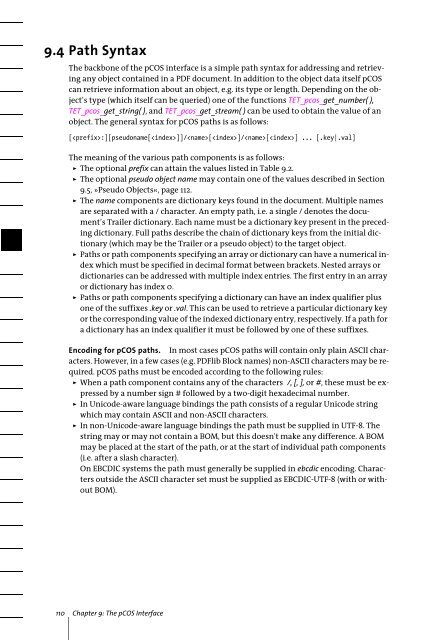PDFlib Text Extraction Toolkit (TET) Manual
PDFlib Text Extraction Toolkit (TET) Manual
PDFlib Text Extraction Toolkit (TET) Manual
You also want an ePaper? Increase the reach of your titles
YUMPU automatically turns print PDFs into web optimized ePapers that Google loves.
9.4 Path Syntax<br />
The backbone of the pCOS interface is a simple path syntax for addressing and retrieving<br />
any object contained in a PDF document. In addition to the object data itself pCOS<br />
can retrieve information about an object, e.g. its type or length. Depending on the object’s<br />
type (which itself can be queried) one of the functions <strong>TET</strong>_pcos_get_number( ),<br />
<strong>TET</strong>_pcos_get_string( ), and <strong>TET</strong>_pcos_get_stream( ) can be used to obtain the value of an<br />
object. The general syntax for pCOS paths is as follows:<br />
[:][pseudoname[]]/[]/[] ... [.key|.val]<br />
The meaning of the various path components is as follows:<br />
> The optional prefix can attain the values listed in Table 9.2.<br />
> The optional pseudo object name may contain one of the values described in Section<br />
9.5, »Pseudo Objects«, page 112.<br />
> The name components are dictionary keys found in the document. Multiple names<br />
are separated with a / character. An empty path, i.e. a single / denotes the document’s<br />
Trailer dictionary. Each name must be a dictionary key present in the preceding<br />
dictionary. Full paths describe the chain of dictionary keys from the initial dictionary<br />
(which may be the Trailer or a pseudo object) to the target object.<br />
> Paths or path components specifying an array or dictionary can have a numerical index<br />
which must be specified in decimal format between brackets. Nested arrays or<br />
dictionaries can be addressed with multiple index entries. The first entry in an array<br />
or dictionary has index 0.<br />
> Paths or path components specifying a dictionary can have an index qualifier plus<br />
one of the suffixes .key or .val. This can be used to retrieve a particular dictionary key<br />
or the corresponding value of the indexed dictionary entry, respectively. If a path for<br />
a dictionary has an index qualifier it must be followed by one of these suffixes.<br />
Encoding for pCOS paths. In most cases pCOS paths will contain only plain ASCII characters.<br />
However, in a few cases (e.g. <strong>PDFlib</strong> Block names) non-ASCII characters may be required.<br />
pCOS paths must be encoded according to the following rules:<br />
> When a path component contains any of the characters /, [, ], or #, these must be expressed<br />
by a number sign # followed by a two-digit hexadecimal number.<br />
> In Unicode-aware language bindings the path consists of a regular Unicode string<br />
which may contain ASCII and non-ASCII characters.<br />
> In non-Unicode-aware language bindings the path must be supplied in UTF-8. The<br />
string may or may not contain a BOM, but this doesn't make any difference. A BOM<br />
may be placed at the start of the path, or at the start of individual path components<br />
(i.e. after a slash character).<br />
On EBCDIC systems the path must generally be supplied in ebcdic encoding. Characters<br />
outside the ASCII character set must be supplied as EBCDIC-UTF-8 (with or without<br />
BOM).<br />
110 Chapter 9: The pCOS Interface
















